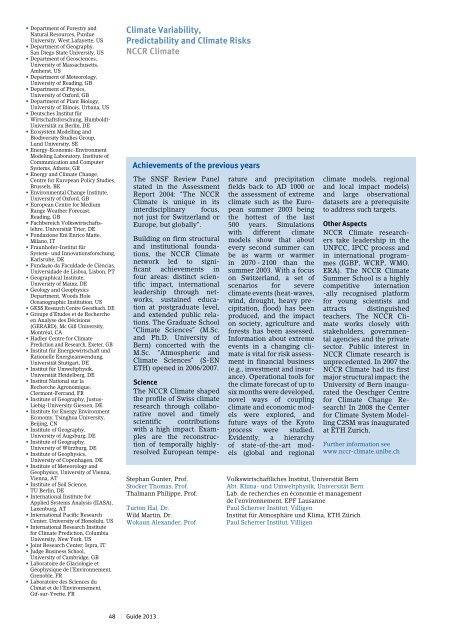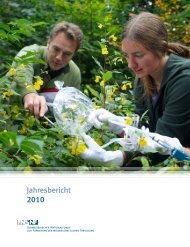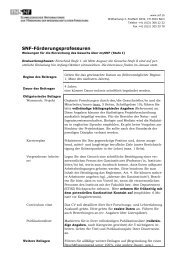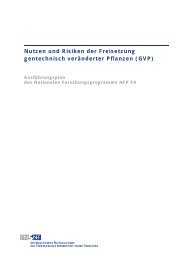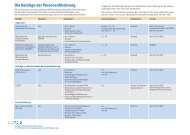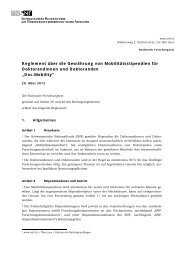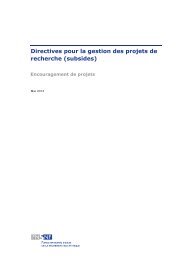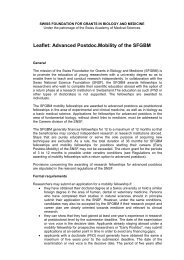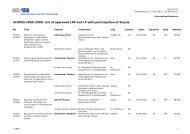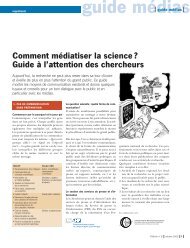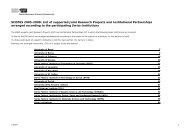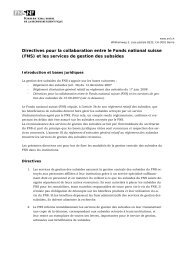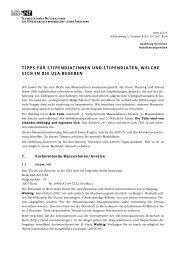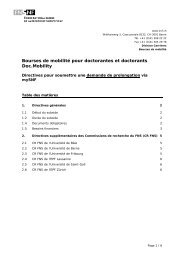NCCR Guide 2013 - Schweizerischer Nationalfonds (SNF)
NCCR Guide 2013 - Schweizerischer Nationalfonds (SNF)
NCCR Guide 2013 - Schweizerischer Nationalfonds (SNF)
Create successful ePaper yourself
Turn your PDF publications into a flip-book with our unique Google optimized e-Paper software.
• Department of Forestry and<br />
Natural Resources, Purdue<br />
University, West Lafayette, US<br />
• Department of Geography,<br />
San Diego State University, US<br />
• Department of Geosciences,<br />
University of Massachusetts,<br />
Amherst, US<br />
• Department of Meteorology,<br />
University of Reading, GB<br />
• Department of Physics,<br />
University of Oxford, GB<br />
• Department of Plant Biology,<br />
University of Illinois, Urbana, US<br />
• Deutsches Institut für<br />
Wirtschaftsforschung, Humboldt-<br />
Universität zu Berlin, DE<br />
• Ecosystem Modelling and<br />
Biodiversity Studies Group,<br />
Lund University, SE<br />
• Energy-Economic-Environment<br />
Modeling Laboratory, Institute of<br />
Communication and Computer<br />
Systems, Athens, GR<br />
• Energy and Climate Change,<br />
Centre for European Policy Studies,<br />
Brussels, BE<br />
• Environmental Change Institute,<br />
University of Oxford, GB<br />
• European Centre for Medium<br />
Range Weather Forecast,<br />
Reading, GB<br />
• Fachbereich Volkswirtschaftslehre,<br />
Universität Trier, DE<br />
• Fondazione Eni Enrico Matte,<br />
Milano, IT<br />
• Fraunhofer-Institut für<br />
System- und Innovationsforschung,<br />
Karlsruhe, DE<br />
• Fundação da Faculdade de Ciências,<br />
Universidade de Lisboa, Lisbon, PT<br />
• Geographical Institute,<br />
University of Mainz, DE<br />
• Geology and Geophysics<br />
Department, Woods Hole<br />
Oceanographic Institution, US<br />
• GKSS Research Centre Geesthach, DE<br />
• Groupe d’Etudes et de Recherche<br />
en Analyse des Décisions<br />
(GERARD), Mc Gill University,<br />
Montréal, CA<br />
• Hadley Centre for Climate<br />
Prediction and Research, Exeter, GB<br />
• Institut für Energiewirtschaft und<br />
Rationelle Energieanwendung,<br />
Universität Stuttgart, DE<br />
• Institut für Umweltphysik,<br />
Universität Heidelberg, DE<br />
• Institut National sur la<br />
Recherche Agronomique,<br />
Clermont-Ferrand, FR<br />
• Institute of Geography, Justus-<br />
Liebig-University Giessen, DE<br />
• Institute for Energy Environment<br />
Economy, Tsinghua University,<br />
Beijing, CN<br />
• Institute of Geography,<br />
University of Augsburg, DE<br />
• Institute of Geography,<br />
University of Würzburg, DE<br />
• Institute of Geophysics,<br />
University of Copenhagen, DK<br />
• Institute of Meteorology and<br />
Geophysics, University of Vienna,<br />
Vienna, AT<br />
• Institute of Soil Science,<br />
TU Berlin, DE<br />
• International Institute for<br />
Applied Systems Analysis (IIASA),<br />
Laxenburg, AT<br />
• International Pacific Research<br />
Center, University of Honolulu, US<br />
• International Research Institute<br />
for Climate Prediction, Columbia<br />
University, New York, US<br />
• Joint Research Center, Ispra, IT<br />
• Judge Business School,<br />
University of Cambridge, GB<br />
• Laboratoire de Glaciologie et<br />
Géophysique de l’Environnement,<br />
Grenoble, FR<br />
• Laboratoire des Sciences du<br />
Climat et de l’Environnement,<br />
Gif-sur-Yvette, FR<br />
Climate Variability,<br />
Predictability and Climate Risks<br />
<strong>NCCR</strong> Climate<br />
Achievements of the previous years<br />
The SNSF Review Panel<br />
stated in the Assessment<br />
Report 2004: “The <strong>NCCR</strong><br />
Climate is unique in its<br />
interdisciplinary focus,<br />
not just for Switzerland or<br />
Europe, but globally”.<br />
Building on firm structural<br />
and institutional foundations,<br />
the <strong>NCCR</strong> Climate<br />
network led to signifi<br />
cant achievements in<br />
four areas: distinct scientific<br />
impact, international<br />
leadership through networks,<br />
sustained education<br />
at postgraduate level,<br />
and extended public relations.<br />
The Graduate School<br />
“Climate Sciences” (M.Sc.<br />
and Ph.D. University of<br />
Bern) concerted with the<br />
M.Sc. “Atmospheric and<br />
Climate Sciences” (S-EN<br />
ETH) opened in 2006/2007.<br />
Stephan Gunter, Prof.<br />
Stocker Thomas, Prof.<br />
Thalmann Philippe, Prof.<br />
Turton Hal, Dr.<br />
Wild Martin, Dr.<br />
Wokaun Alexander, Prof.<br />
Science<br />
The <strong>NCCR</strong> Climate shaped<br />
the profile of Swiss climate<br />
research through collaborative<br />
novel and timely<br />
scientific contributions<br />
with a high impact. Examples<br />
are the reconstruction<br />
of temporally highlyresolved<br />
European temperature<br />
and precipitation<br />
fields back to AD 1000 or<br />
the assessment of extreme<br />
climate such as the European<br />
summer 2003 being<br />
the hottest of the last<br />
500 years. Simulations<br />
with different climate<br />
models show that about<br />
every second summer can<br />
be as warm or warmer<br />
in 2070 - 2100 than the<br />
summer 2003. With a focus<br />
on Switzerland, a set of<br />
scenarios for severe<br />
climate events (heat-waves,<br />
wind, drought, heavy precipitation,<br />
flood) has been<br />
produced, and the impact<br />
on society, agri culture and<br />
forests has been assessed.<br />
Information about extreme<br />
events in a changing climate<br />
is vital for risk assessment<br />
in financial business<br />
(e.g., investment and insurance).<br />
Operational tools for<br />
the climate forecast of up to<br />
six months were developed,<br />
novel ways of coupling<br />
climate and economic models<br />
were explored, and<br />
future ways of the Kyoto<br />
process were studied.<br />
Evidently, a hierarchy<br />
of state-of-the-art models<br />
(global and regional<br />
Volkswirtschaftliches Institut, Universität Bern<br />
Abt. Klima- und Umweltphysik, Universität Bern<br />
Lab. de recherches en économie et management<br />
de l’environnement, EPF Lausanne<br />
Paul Scherrer Institut, Villigen<br />
Institut für Atmosphäre und Klima, ETH Zürich<br />
Paul Scherrer Institut, Villigen<br />
cli mate models, regional<br />
and local impact models)<br />
and large observational<br />
datasets are a prerequisite<br />
to address such targets.<br />
Other Aspects<br />
<strong>NCCR</strong> Climate researchers<br />
take leadership in the<br />
UNFCC, IPCC process and<br />
in international programmes<br />
(IGBP, WCRP, WMO,<br />
ERA). The <strong>NCCR</strong> Climate<br />
Summer School is a highly<br />
competitive internation<br />
-ally recognised platform<br />
for young scientists and<br />
attracts distinguished<br />
teachers. The <strong>NCCR</strong> Climate<br />
works closely with<br />
stakeholders, governmental<br />
agencies and the private<br />
sector. Public interest in<br />
<strong>NCCR</strong> Climate research is<br />
unprecedented. In 2007 the<br />
<strong>NCCR</strong> Climate had its first<br />
major structural impact: the<br />
University of Bern inaugurated<br />
the Oeschger Centre<br />
for Climate Change Research!<br />
In 2008 the Center<br />
for Climate System Modelling<br />
C2SM was inaugurated<br />
at ETH Zurich.<br />
Further information see<br />
www.nccr-climate.unibe.ch<br />
48 | <strong>Guide</strong> <strong>2013</strong>


